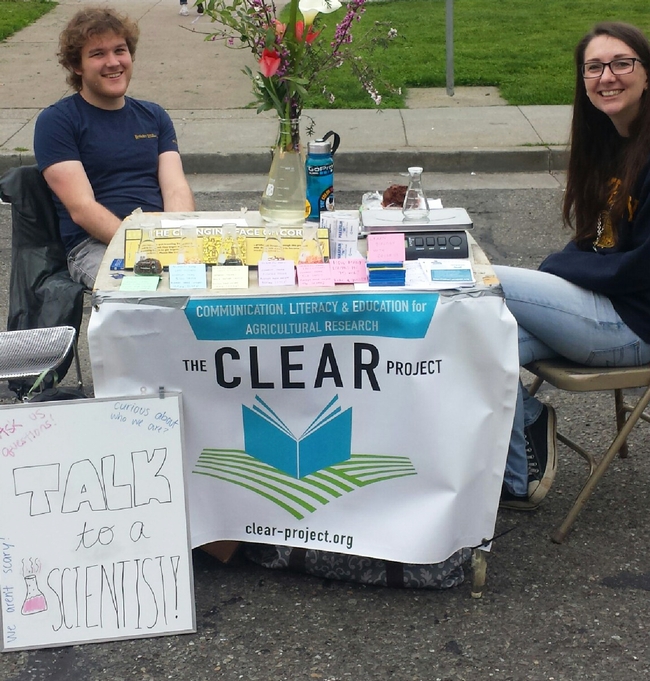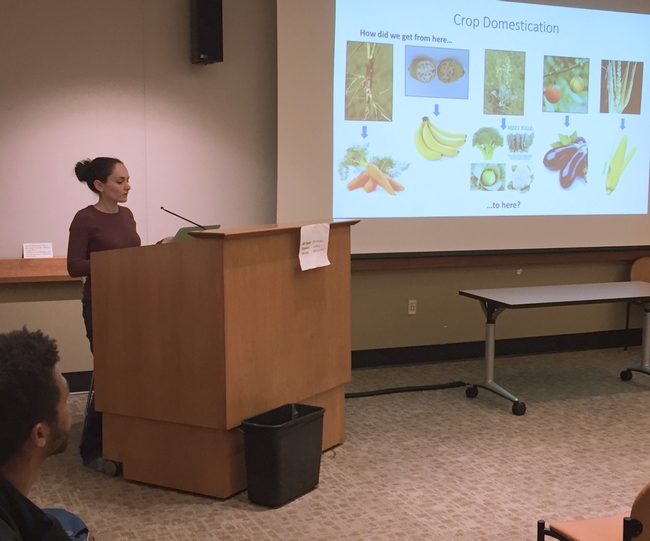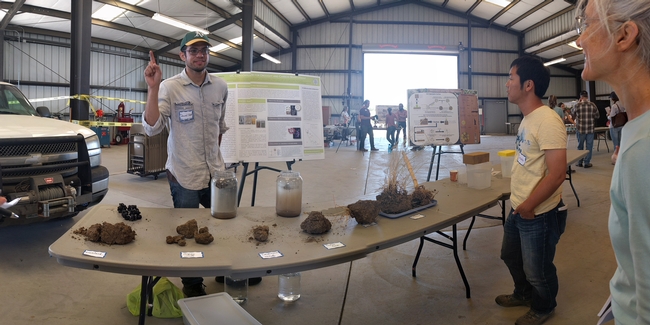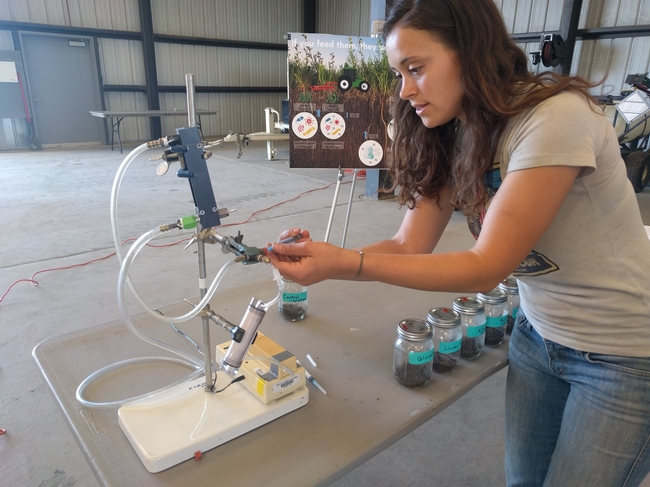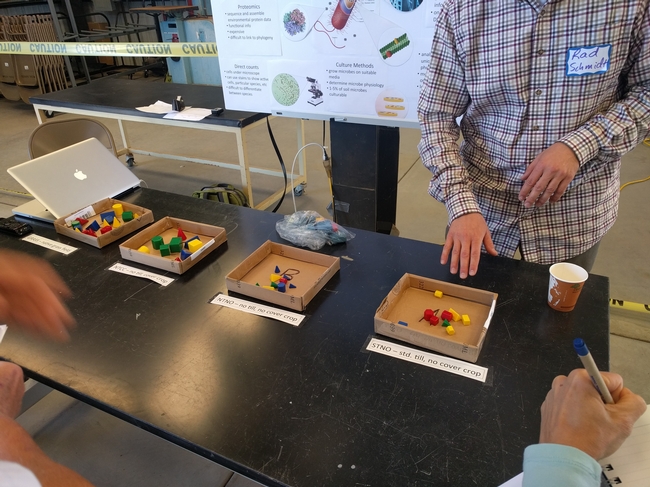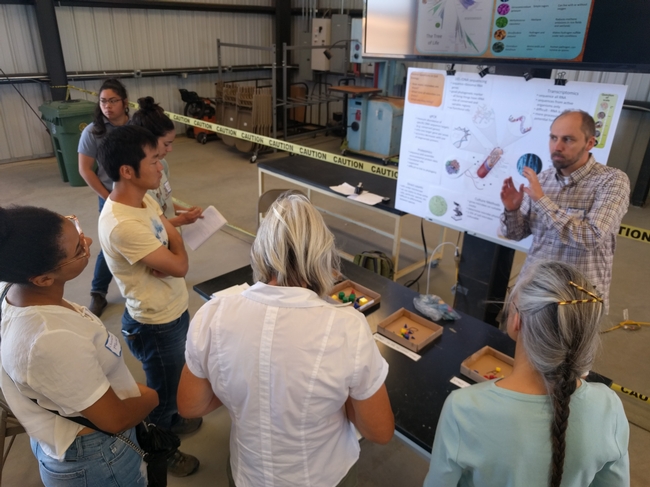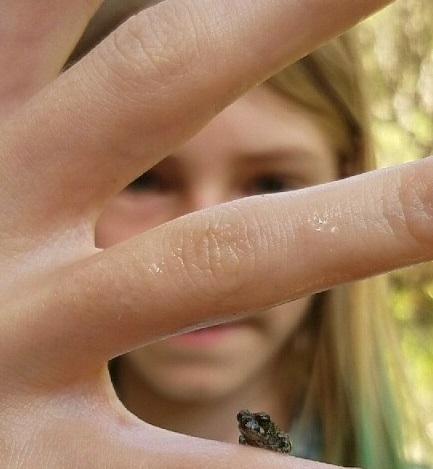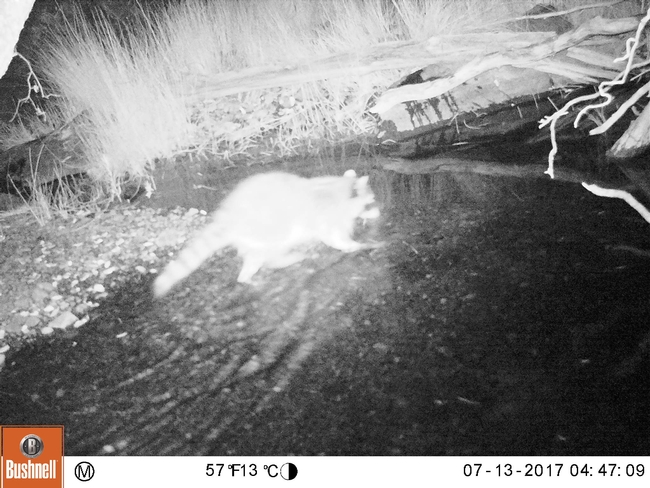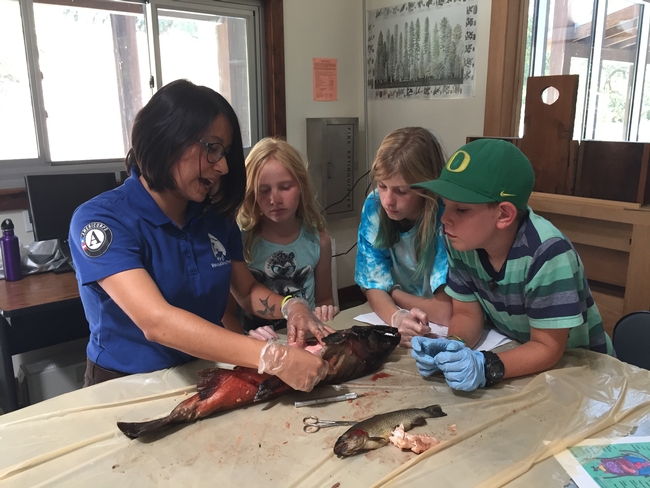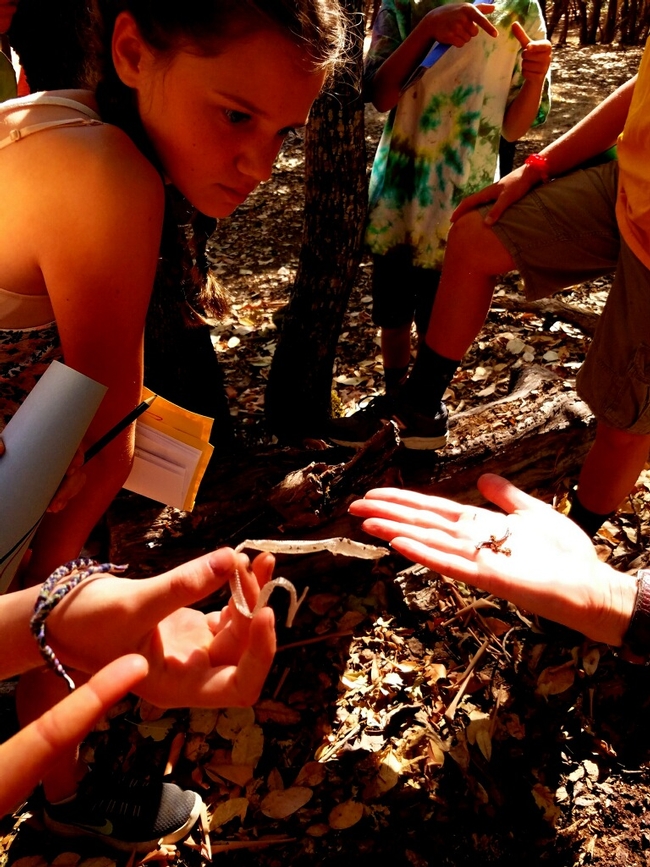Posts Tagged: education
Third Graders Learn About Pollinators
(June 17-23 is National Pollinator Week.) "How many species of bees are there in the world?" asks Wendy Mather, program manager of the California...
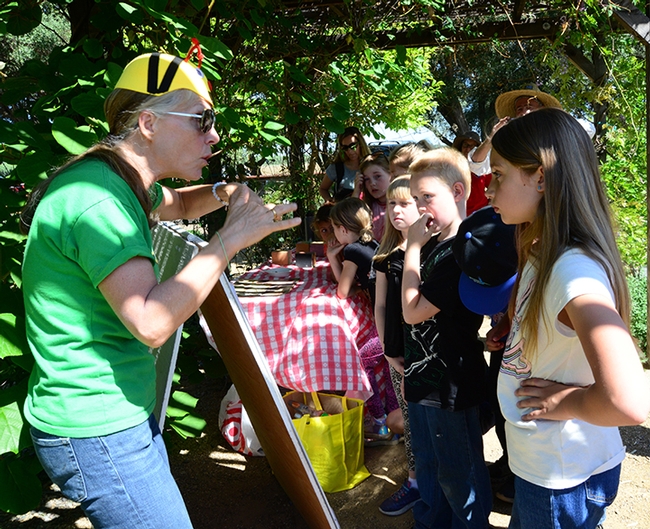
Wendy Mather (left) program manager of the California Master Beekeeper Program, explains the life cycle of bees to a group of third graders from Amador County. (Photo by Kathy Keatley Garvey)
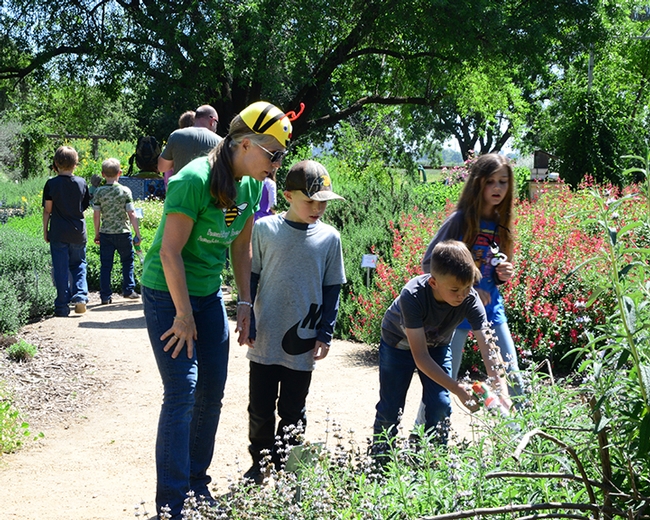
Wendy Mather (left) program manager of the California Master Beekeeper Program shows the third graders how to use a bee vacuum in a catch-and-release activity. (Photo by Kathy Keatley Garvey)
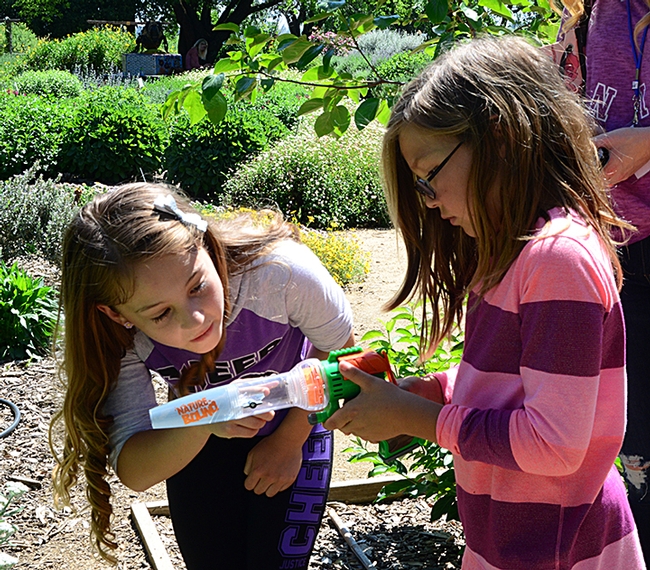
I can see the bee! There it is! (Photo by Kathy Keatley Garvey)
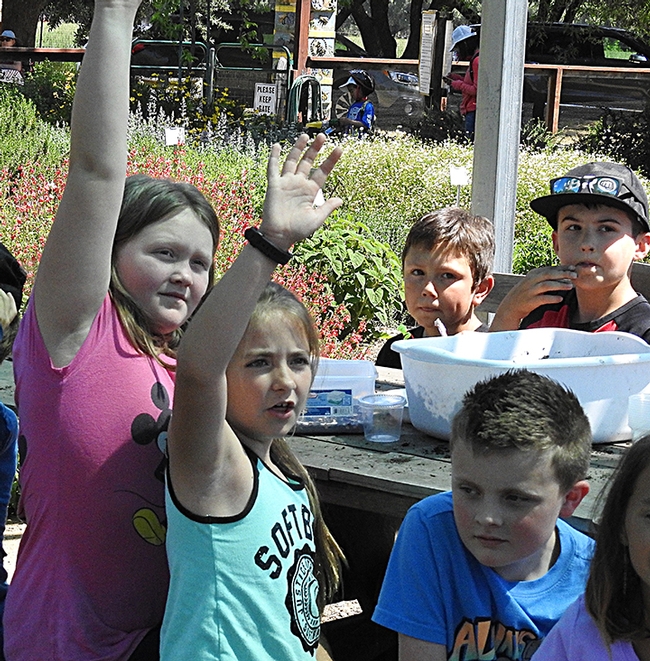
What kind of butterfly is this? The answer: Monarch! (Photo by Kathy Keatley Garvey)
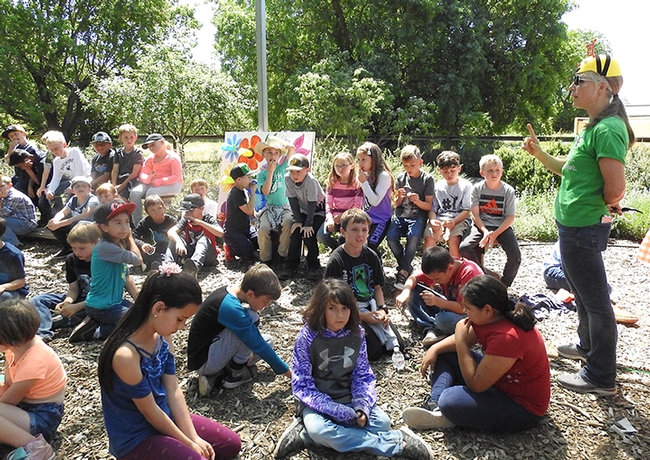
Wendy Mather, program manager of the California Master Beekeeper Program (CAMBP), tells the students she hopes to see them study entomology at UC Davis. (Photo by Kathy Keatley Garvey)
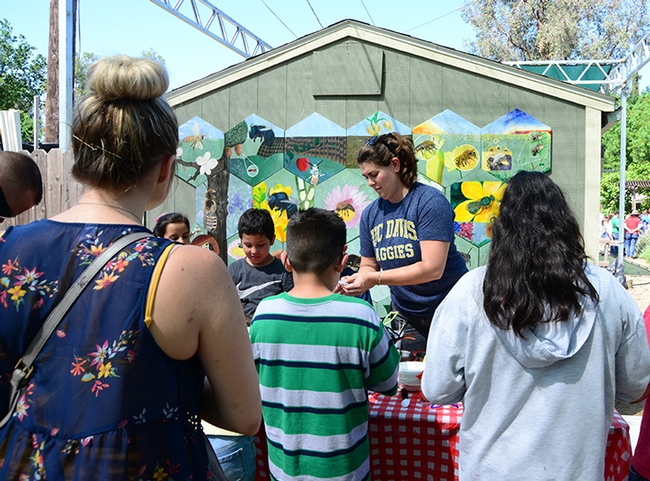
Volunteer Julia Wentzel introduced the concept of "pollinator specialists" and engaged the students in creating a "pollinator." They then transferred "pollen" to different shaped flowers. (Photo by Kathy Keatley Garvey)
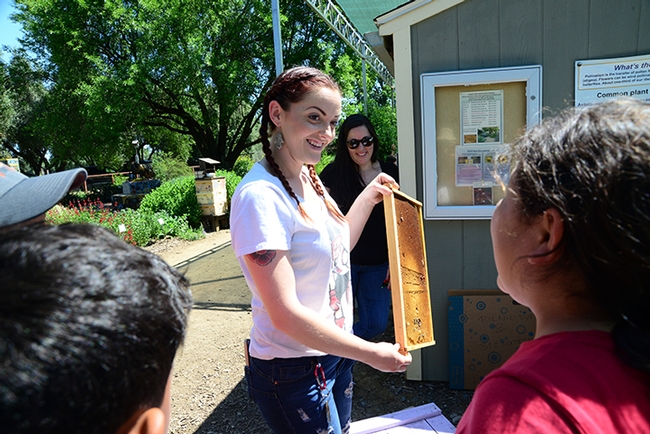
Volunteer Robin Lowry, who managed the “Planting for Pollinators” and “Be a Beekeeper” station, displays a frame. (Photo by Kathy Keatley Garvey)
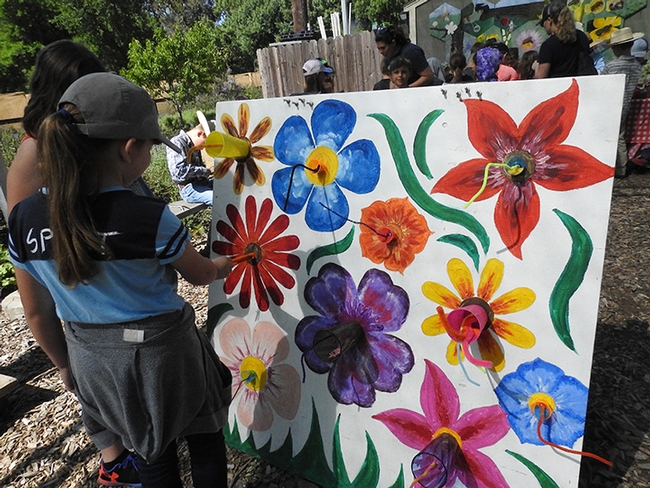
Students placed "pollinators" inside flowers. (Photo by Kathy Keatley Garvey)
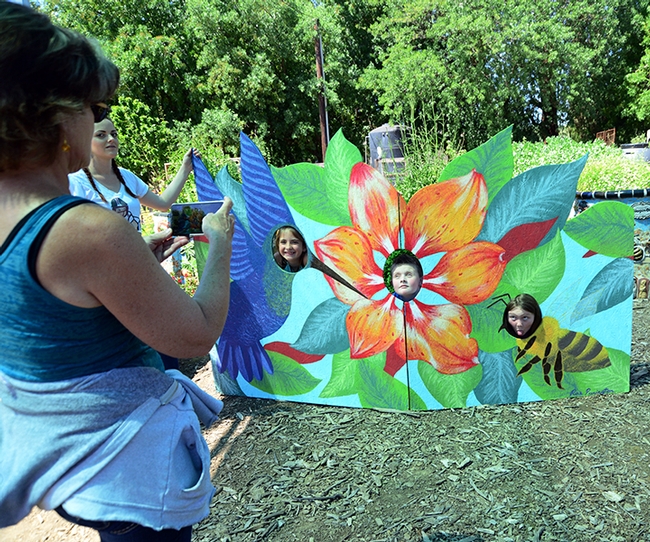
Time to take a photo! Don't say "cheese!" Say "honey!" (Photo by Kathy Keatley Garvey)
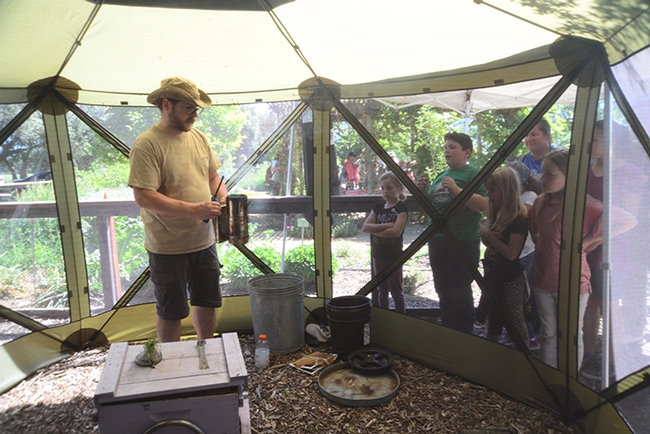
Matthew Hoepfinger, staff research associate in the E. L. Niño lab, presented the live bee demonstration. (Photo by Kathy Keatley Garvey)
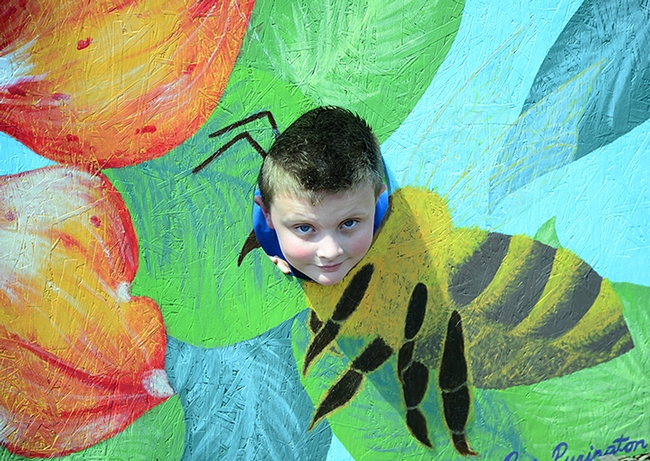
Hey, I'm a bee! (Photo by Kathy Keatley Garvey)
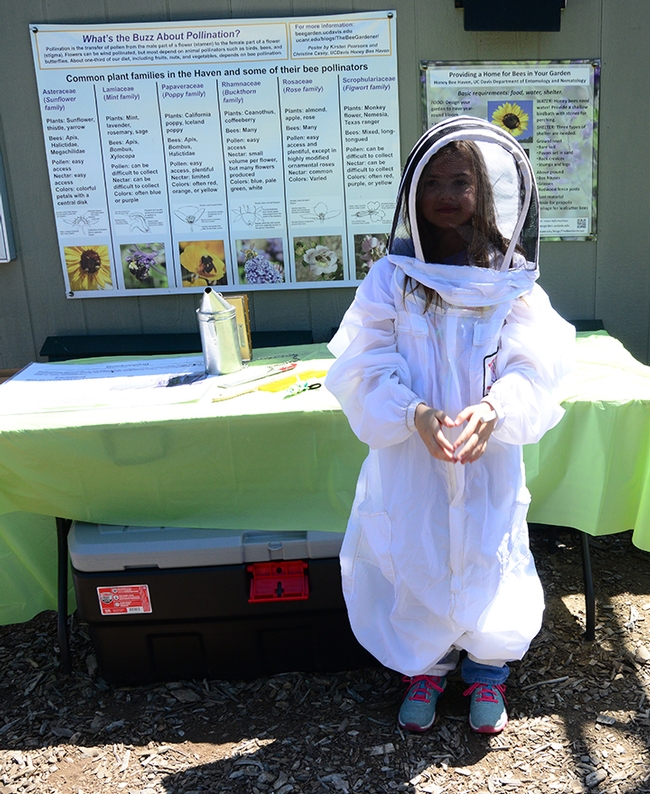
A little beekeeper shapes a heart. Students took turns trying on the beekeeper protective suits. (Photo by Kathy Keatley Garvey)
Hear that Buzz? Saturday is National Honey Bee Day!
Hear that buzz? Tomorrow (Saturday, Aug. 18) is National Honey Bee Day. A small group of beekeepers originated the observance back in 2009 to...
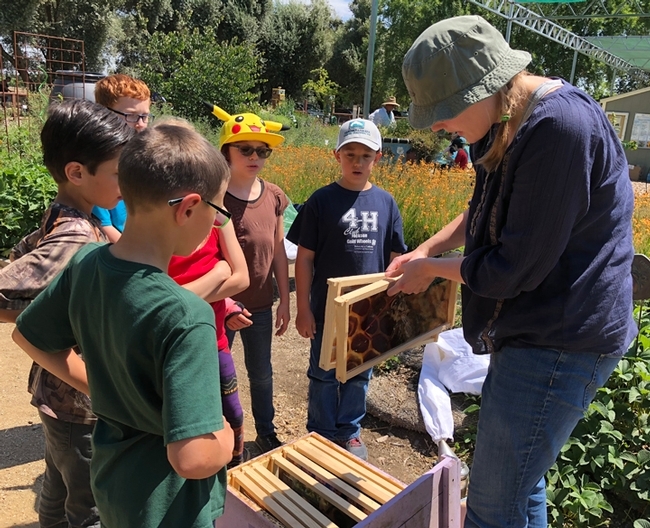
Postdoctoral scholar Laura Brutscher of the Elina Lastro Niño lab at UC Davis talks about who lives in the hive. (Photo by Kathy Keatley Garvey)
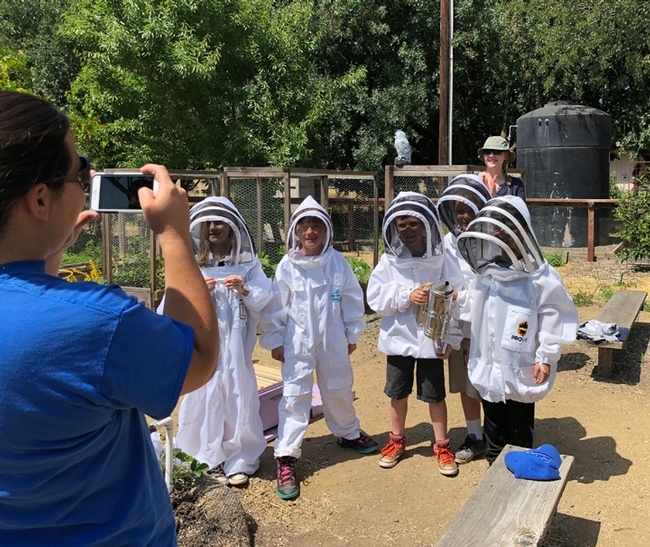
The youngsters enjoy dressing up in beekeeper protective suits and being photographed. (Photo by Kathy Keatley Garvey)
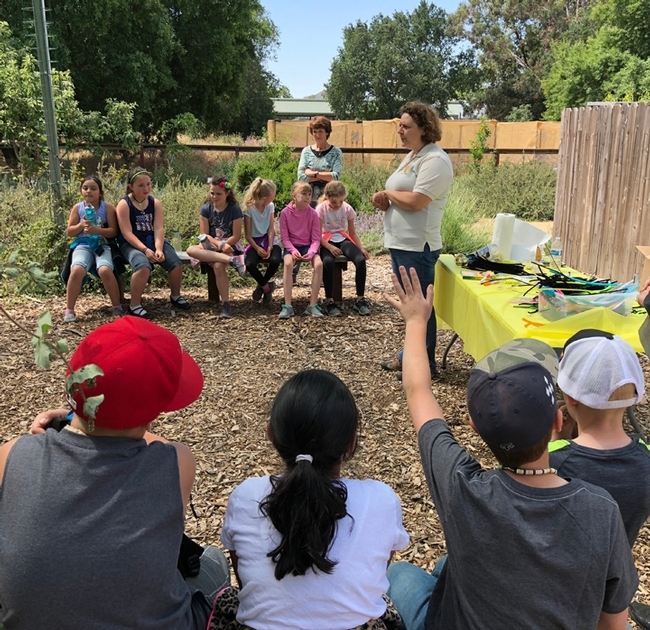
Extension apiculturist Elina Lastro Niño talks about the importance of pollination. (Photo by Kathy Keatley Garvey)
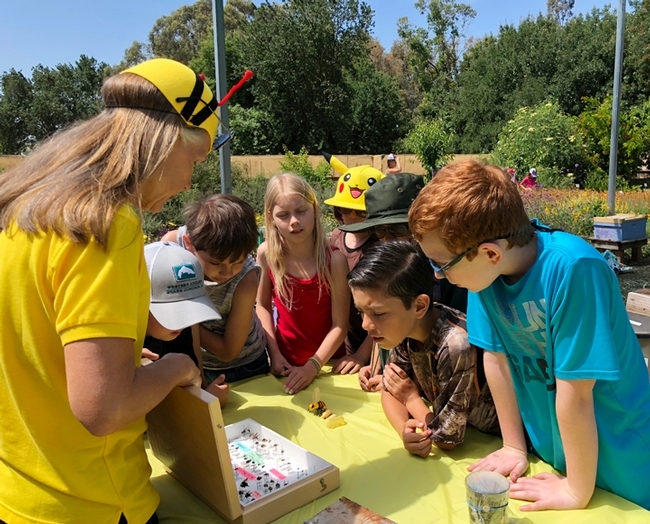
Wendy Mather of the California Master Beekeeper Program shows the youngsters bee specimens. (Photo by Kathy Keatley Garvey)
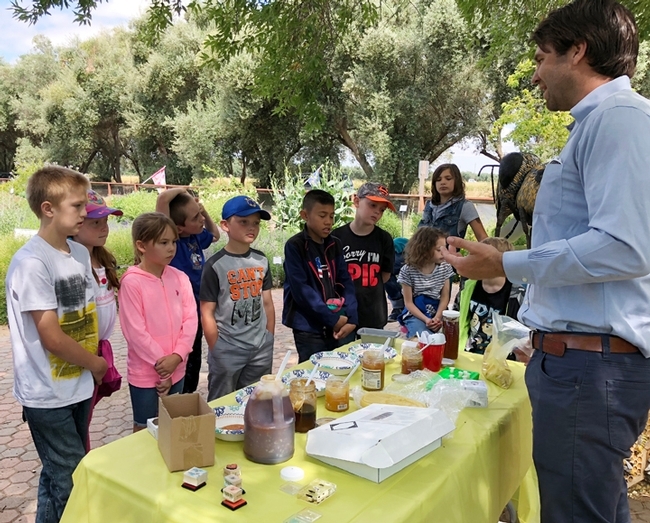
Charley Nye, manager of the Harry H. Laidlaw Jr. Honey Bee Facility, introduces the students to honey varietals. (Photo by Kathy Keatley Garvey)
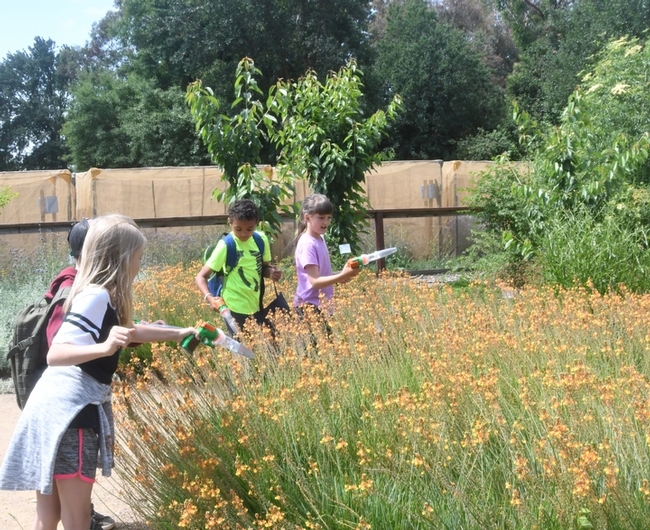
The students catch, examine and release bees with bee vacuum devices. (Photo by Kathy Keatley Garvey)
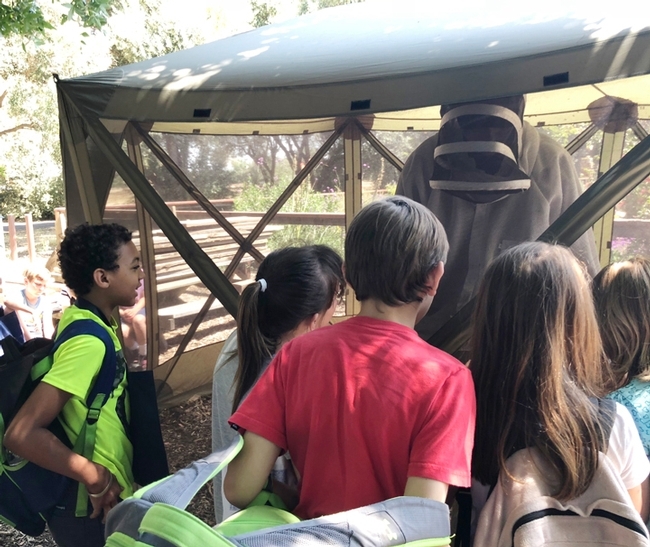
Marcel Ramos of the Niño lab opens a hive inside a netted enclosure. (Photo by Kathy Keatley Garvey)
Scientists-in-training learn to tell a CLEAR story
On the second Saturday of every month, Tuesday Simmons heads to the downtown Berkeley farmers market. Among the produce stalls and coffee stands, she sits behind a table with a sign that reads “Talk to a scientist!” She and other students spend the day fielding questions from strangers about topics that range from genetically modified foods to climate change and more.
“We never know who we'll talk to at our public events, or what kinds of questions we'll be asked,” said Simmons, a graduate student in the UC Berkeley Department of Plant and Microbial Biology (PMB). “This makes the farmers markets fun.”
Simmons' monthly visits to the farmers market are organized by the student group CLEAR (Communication, Literacy, and Education for Agricultural Research). The group aims to mentor the next generation of science communicators by engaging in open, transparent, and active conversations with the public about science and research. Funded through the University of California Global Food Initiative, CLEAR offers a series of scientific outreach events including activities at the farmers market, student-led lectures at libraries, and discussions with the public at local pubs.
The events are aimed at making science accessible.
“For members of the public who think scientists are a group of scary, isolated individuals funded by companies with special interests, these brief exchanges can be enough to make them question that assumption,” said Simmons, who also noted that translating her microbiology research for the public has helped improve her communication skills.
Learning to create compelling and impactful science communications is also a draw for Daniel Westcott, who joined the group in 2015. As a PMB graduate student who studies a specialized field — photosynthetic energy conversion in algae and plants — Westcott noted that discussing his research with non-scientists felt like a challenging hurdle to overcome.
Students like Westcott practice their communications skills through writing for the CLEAR blog. In their monthly blog posts, group members have tackled the economics of the meat industry, and the science behind the Impossible Burger, and the difficulty in labeling foods as “natural,” as well as highlighting CLEAR's ongoing outreach efforts.
Westcott understands that sharing his research with the public through the blog and other CLEAR activities is essential.
“Nearly two million scientific articles are published each year,” Westcott said. “Today's successful scientists must be media savvy in order to rise above the noise.”
Launched in 2015, CLEAR began as a project across three UC campuses — Berkeley, Davis, and San Diego. At Berkeley, co-founders Peggy Lemaux and Dawn Chiniquy, a PMB postdoctoral fellow, saw the funding as an opportunity to focus on outreach activities and mentorship opportunities, such as helping graduate students write for and talk to non-scientific audiences.
Lemaux is a UC Cooperative Extension specialist and PMB faculty member who studies food crop performance and quality. She said CLEAR is a student-driven organization. All members of CLEAR are volunteers, and a mix of undergraduates, graduate students and postdoctoral researchers participate in the group's activities. Many of members are PMB students, but students from other scientific fields also participate in CLEAR's events and monthly meetings. Student scientists from across campus are welcome.
As the faculty organizer of CLEAR, Lemaux mentors students by providing feedback and guidance on their public presentations and blog posts. Recent student-led lecture topics include pesticide use and genetically modified foods, and as new members join the group, they'll continue to add new presentations to their calendar of events.
CLEAR also hosts workshops and trainings to foster students' science communication and writing skills. Last spring, the group invited NPR science writer Joe Palca to present a talk, “Real News or Fake Science.” More recently Brian Dunning of Skeptoid gave a presentation tittled “Science Communication in a Minefield of Fiction.” This fall, Sara ElShafie, a graduate student in the Department of Integrative Biology and founder of Science Through Story, will give a science communication workshop for CLEAR students.
In recent years, Lemaux has seen a shift in students' interest in outreach and science communication.
“Today's generation of scientists understand that they must be scientists in the lab and translate the message of their research — and research in general — for the public,” she said.
Some CLEAR students have pursued careers in public communication after leaving Berkeley. Mikel Shybut, PhD ‘15 Plant Biology, is now a fellow at the California Council on Science and Technology where he provides scientific analyses to state legislators. After arranging a day of informational meetings in Sacramento for a group of CLEAR students, Shybut commented, “It's heartening to see what CLEAR has accomplished in the last two years. The group's outreach efforts demonstrate that scientists can be effective messengers.”
Visit CLEAR's calendar to learn more about upcoming events. In September join CLEAR at the following events:
-
Downtown Berkeley Farmers Market: Come chat with CLEAR members and check out their science demos at the farmers market. They feature a different science theme each month and are always looking forward to listening to community members' science questions and concerns.
-
Science Café with PMB professor John Taylor: Join CLEAR members for a beer, fun fungus exhibits, and Dr. John Taylor's tentatively titled "Felons, Fungi and Rats: California's Valley Fever Epidemic.”
Powers of microbes: UC Davis graduate students get creative to teach farmers about soil microbiology
If you grew up in the 1980s or 1990s (or were a child at heart during that era), the famous Powers of Ten film likely left an indelible mark in your mind.
The film starts with a couple lounging on a picnic blanket and zooms out to the outer reaches of the universe, then back in to peer into the microscopic world of the human body: from white blood cells to DNA, and finally down to the proton of a carbon atom.
In its short 9-minute run time, Powers of Ten manages to inflame an existential angst about the size of a single human life while at the same time connecting the viewer to the beauty of the universe and the human body.
As a high school student watching the video, it filled me with the same sense of awe that I felt the first time I heard Carl Sagan's famous quote that “we are all made of star stuff.”
Powers of Ten reminds us that looking at the world from different perspectives, from the very tiny to the immensely large, helps create a better understanding of the natural world, our place within it, and how we can impact it for good.
Had Powers of Ten returned from outer space by zooming into a piece of soil rather than a the human body, it would have explored the billions of living creatures in one handful of soil, slowly scaling down from millipedes to earthworms to ants to nematodes to protozoa, and finally down to the soil's bacteria and fungi that make up the base of the soil food web.
The video might then have looked a lot like the recent workshop at the Russell Ranch Sustainable Agriculture Facility, which served as a science fair for farmers and researchers to learn about the minuscule but powerful soil microbe.
While farmers often have a baseline knowledge about soil microbiology and its importance on the farm, “the science is evolving so quickly at this point, that it can be hard to keep up,” said attendee Margaret Lloyd, UC Cooperative Extension advisor who works with small-scale farmers in Yolo and Sacramento counties.
The workshop coupled foundational principles of soil microbiology with practical on-farm management situations, making the case for farmers to actively consider soil bacteria, fungi, and other micro organisms in their decision-making process.
Jessica Chiartas, a fourth-year graduate student in soil microbiology and one of the workshop organizers, is somewhat of a soil science evangelist.
Her hope was to help workshop attendees better understand that “soils are not just physical, chemical systems. A majority of the processes that take place underfoot are biologically driven. Soils are living and breathing bodies and much like us, they need to be fed, covered, and protected from disturbance” in order to function in the long term.
Scaling down
The scale of microbial activity in soil makes it challenging to help farmers dig into just what scientists are talking about when they talk about microbes.
“It's important to talk about the scale of microbes,” Chiartas said. “So much of what goes on in soils is mediated by microbes and the scale that they operate on is far different than the scale we measure them at. Our typical method of soil sampling and analysis is analogous to harvesting whole fields of crops, chopping them up, throwing them in a heap and then trying to glean information about the individual plants.”
The presenters at the soil health workshop used vivid analogies to translate the abstract results of scientific research and hard-to-imagine scales into concrete, relatable concepts.
A single gram of soil may contain a billion bacteria, and several miles of fungal hyphae, the web-like growth of fungus. Translated into human scale, the numbers are mind boggling.
If a single microbe were a 6-foot-tall person, then a single millimeter of soil would be as tall as the empire state building. A typical soil bacterium contains as many DNA letters in its chromosome as two copies of “War and Peace.” A stack of copies of “War and Peace” equivalent to bacterial DNA from a single teaspoon of soil would be larger than the Great Pyramid of Giza.
A soil information revolution
The metaphors of scale are a fun thought experiment, and they could provide a jumping-off point for a discussion between farmers and scientists essential for improving our current understanding of soil as a living system. Climate change is expected to amplify the effects of soil erosion, compaction, nutrient leaching and other issues common in our current agricultural systems.
“We need improved management that works with the soil ecosystem to increase crop production while enhancing soil health,” said Radomir Schmidt, a postdoctoral researcher and workshop organizer. ”That's going to take a concerted effort and open dialog between farmers, scientists, and citizen scientists to discover, test, and implement these methods in the real world.”
We are now in the era of “soil information revolution," Schmidt said. As our knowledge of the soil microbiome expands, implementing this knowledge in agricultural practice is more and more possible.
This graduate student cohort is well-positioned to make the necessary connections, learning from farmers while helping them zoom in to see the essential lifeforms that impact their farm, then zoom out to help make decisions that are good for the farmer, good for the crop, and good for the microbe.
Farmers in the Davis area will have another opportunity to learn soil health fundamentals at a workshop this fall hosted by the UC Sustainable Agriculture Research and Education Program and Russell Ranch Sustainable Agriculture Facility. Details about the workshop will be posted here.
Caging kids! The next generation of wildlife biologists
As 10-year-old Dominic Vargas crouched on the ground, in a cage not much larger than himself, trying to forage for tasty treats (candy) on the woodland floor...CRASH! The cage door came falling down and he realized that he had inadvertently tripped a tiny fishing line in his efforts to reach that candy - he was now trapped. Dominic seemed to accept his fate with good humor, shrugging, smiling and getting to work on that candy. Wildlife biologist, Jessie Roughgarden, commented that Dominic will now be collared, tagged and measured before returning him to the wild ... or in this case his parents.
This seemingly terrifying experience is in fact all part of the new "Sustainable You - 4-H Summer Camp" held at the UC Hopland Research and Extension Center. Sustainable You is a five-day camp allowing students to experience science and nature while learning about ways in which to conserve the land, water, air and energy.
View Dominic's experience in this 44-second video:
The camp is conducted at three of the UC Agriculture and Natural Resources' Research and Extension Centers across the state and each center tweaks the curriculum to suit their landscape and the kinds of research conducted at their sites. At Hopland this means getting the chance to meet with wildlife biologists from the UC Berkeley "Brashares Lab," led by professor Justin Brashares. It's an amazing opportunity for these kids to meet and ask questions of scientists conducting experiments in the countryside that surrounds them. Dominic may not be collared, but more than 10 deer on the property went through the same experience last week (minus the candy) as they were carefully captured by researchers and fitted with collars to better understand their movements and population across the 5,358-acre center.
The young team of scientists enjoying summer camp were also working to understand what wildlife shares the landscape with them by setting wildlife cameras daily and improving their positioning and locations each day. Advice from Brashares and Jessie Roughgarden helped the students improve their chance of catching footage of raccoons, foxes and maybe even a mountain lion. Day one produced fox video footage and shots of raccoons feeling around in the last pools of creek water to catch some of the tiny young frogs currently in residence.
Hear what Ahmae saw on her wildlife camera in the 59-second video below:
Exposure for these kids not only to hands-on activities exploring sustainability, but also to wildlife biologists, young researchers and professors working on today's wildlife and land management challenges, gives them an open door to explore their own future careers and interests.
As 9-year-old Ahmae Munday so sweetly put it, when asked what her favorite part of the Sustainable You Summer Camp was, "Everything! Especially the cameras."
The UC ANR network of Research and Extension Centers provide the perfect location to offer exposure to youth and communities to better understand and interact with the science going on in their own back yards and to inspire the next generation of researchers - as camp attendee and scholarship recipient Kaiden Stalnaker described in his scholarship application, "When I grow up I dream of a career in science and your camp would be a boost in the right direction."
Thanks to the researchers, camp counselors and students who have allowed the Sustainable You summer camp to inspire young people like Kaiden.


